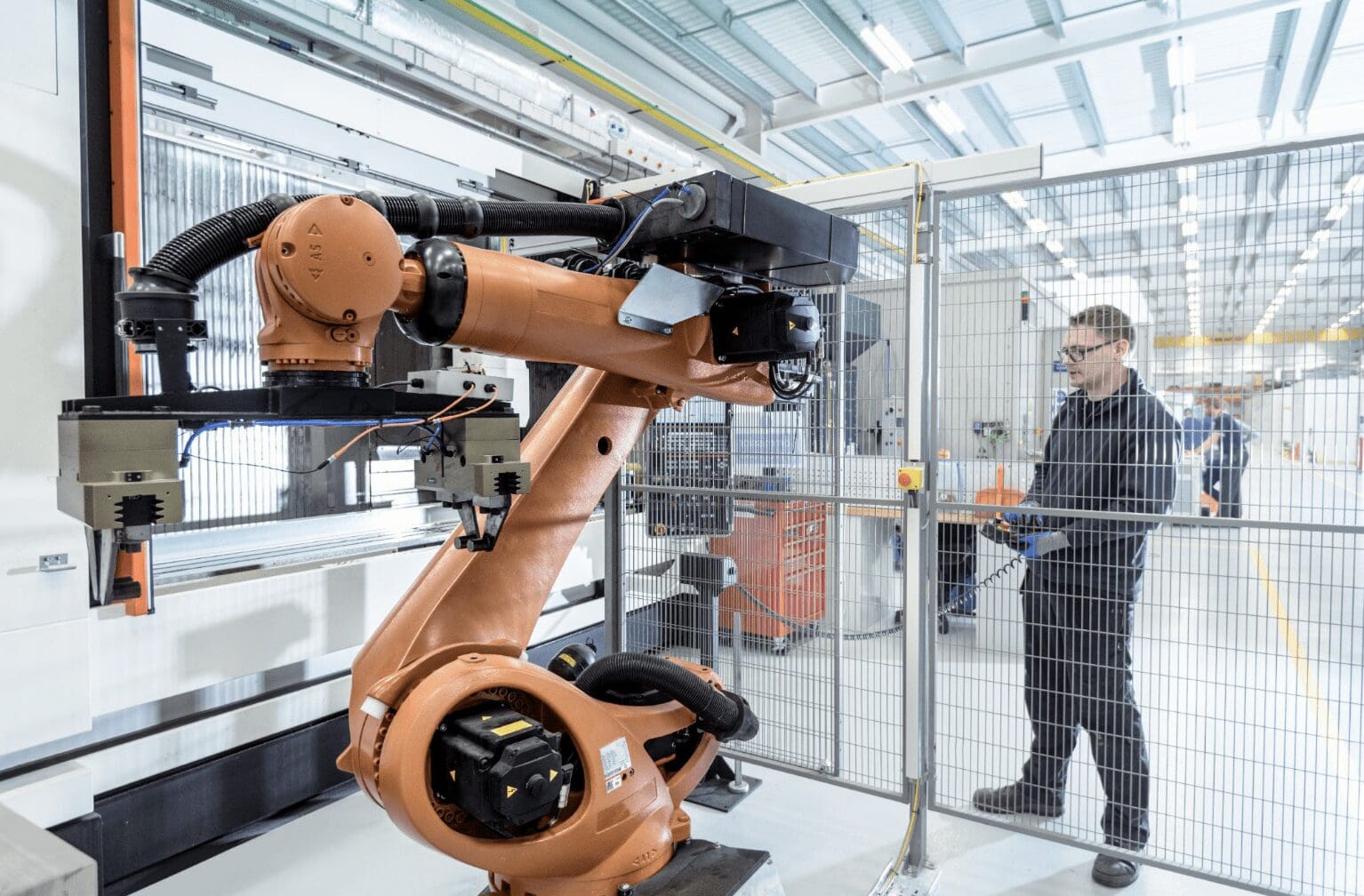By: Daren Fonda
Midway through a mission to deliver food at George Mason University in Virginia, the little white robot paused. A throng of students headed its way, blocking its path to its destination. The robot weighed its choices: It could let the students pass, attempt a runaround, or try to barrel through. A few seconds elapsed, a decision was made. Whirring up again, the robot splintered the group as it trundled down the middle.
“Sometimes they’ll come at your legs a bit,” says Alice Christensen, an anthropology major who had just opened the lid of another robotic vehicle, taking out her Subway sandwich. Christensen, 22, often summons the vehicles, made by a start-up called Starship Technologies, to deliver food from a campus restaurant, using an app similar to Grubhub or Uber Eats. She doesn’t mind the fees, typically $2.50 a delivery, though she does get annoyed at the occasionally glitchy app and dozens of Starship vehicles that roam the campus, making hundreds of deliveries a day.
“They’re really convenient when you’re pressed for time, but they can be a nuisance,” she says.
Robots, while very much imperfect, are moving up in the world. Labor shortages and rising wage costs are breathing life into a new generation of robots that can handle basic tasks, from delivering pizza to sorting prescription drugs, fixing a tire or providing room service in a hotel.
The machines are called “cobots” for their collaborative roles with people. They are replacing workers lost in the pandemic. And they are likely to play far bigger roles in the labor force as demographic pressures, worker shortages, and technology all converge—making robot economics far more attractive.
“Postpandemic, there are a lot of jobs that people have decided they don’t want to do,” says Jeff Burnstein, president of the Association for Advancing Automation, an industry trade group.
Robots appear to be getting a pandemic lift. Global sales hit a record $15.5 billion in 2021 and are on track to grow 10% this year, to around $17 billion, according to the International Federation of Robotics, a trade group. More than 517,000 robotic units were installed globally in 2021, 31% above 2020’s total. Worldwide sales of robotic units will top 600,000 this year, the trade group estimates.
Cobot sales are also rising steadily, with 39,000 units installed in 2021—50% over 2020’s level and a big jump from 2017, when 11,000 were installed.
By a broader definition of “robot,” including industrial, hospitality, and automated vehicles for logistics and assembly lines, total sales could hit $160 billion to $260 billion in 2030, up from $40 billion in 2023, according to estimates from the Boston Consulting Group. Much of that growth will be in services for things like hotels, meal delivery, recycling plants, and airport maintenance. Services will account for up to $170 billion of annual sales volume, BCG says, coming to “dominate the sector.”
“There’s a reason why everyone is talking about services robots,” says Patrick Schwarzkopf, managing director of the VDMA Robotics + Automation Association, a trade group. “They can do something sensible in many walks of life, like flipping burgers, milking cows, surgery, or lab work.”
Rising labor costs worldwide are giving robot economics a boost. Factory wages in China have doubled since 2007, making robotics more economical for assembly-line work. In the U.S., minimum wages are rising in many states and localities. A Fast Food Council in California is expected to set a $22 minimum for fast-food workers this year. In Washington, D.C., restaurants will have to pay at least $16.10 hourly in 2027, shifting the bulk of labor costs for servers from tips to company payrolls.
“How can you pay all these people $16 an hour? You can’t,” says Osman Barrie, owner of the Steak N Egg Diner in Washington, where a robot named “Servi” ferries food from the nearby kitchen to tables. Barrie leases the device from a start-up called Bear Robotics, paying $639 a month with a subsidy from Pepsi, which advertises on the vehicle. Humans load plates of food on its trays, press a button on a keypad, and send it to a table.
“Please take your food,” Servi says to a couple who had ordered lunch, while a human employee hovers nearby. “This is just the beginning of helper tools,” says Bennett Marshall, 82, who takes his food from the robot’s tray, much amused by his automated server.
Similar scenes are playing out in Europe, where worker shortages and soaring energy costs have led to service cuts at hotels and restaurants.
“The lack of service personnel is insane,” says Oliver Stahl, CEO of Robotise, a German company that sells the Jeeves robot for hotel room service, delivering things like minibar drinks and toiletries. Hotels in Europe are still only 50% to 60% staffed from pre-Covid levels, he says. Electricity is so expensive that some hotels have removed minibars to conserve energy. “The megatrend you see in the hotel industry is service automation, wherever you go,” he adds.
The other big growth driver is technology. Advances in 3-D vision systems, location mapping, and mechanical engineering are making robots more useful and user-friendly. New models come equipped with touch screens or tablets that anyone can operate, no coding skills required. “Swarm intelligence” allows robots to share tasks and work together. And robots are getting connected through 5G and Wi-Fi networks, allowing companies to monitor, program, and troubleshoot remotely.
Artificial intelligence is helping robots handle more unexpected situations—enabling them to work with people without getting into trouble. While robots in industrial settings tend to be stationary or segregated in areas for safety, services robots must sense their surroundings and potential dangers. Software advances equip them with situational awareness to adjust on the fly; a Starship bot, for instance, waited patiently at a crosswalk on George Mason’s campus, programmed not to cross until no car is in sight.
To make it all profitable, the industry is pitching “robot as a service” subscription models, aiming to generate recurring revenue while keeping capital outlays for the machines down. Bear, for instance, has deployed hundreds of its Servi robots to bus tables and serve food and drinks at restaurants such as Denny’s and Chili’s. Restaurants pay $700 to $800 a month, equating to an average wage of $2.50 an hour, says Juan Higueros, co-founder of Bear.
“Minimum wages for these roles are sometimes five to seven times more than what it costs a robot to do the bussing and serving,” he says. Bear’s robots can travel about four feet per second. Even if they save a minute or two of time for a server, that can provide more opportunities to refill drinks or suggest other food items, lifting the table’s bill. “The robot provides that last piece of hospitality,” he says.
A big question is whether any of these robots will take a person’s job and earn its keep, saving companies on labor costs. For now, the services robots appear to be doing jobs that are hard to fill. Hotels, restaurants, and healthcare and industrial workplaces are all hankering for more help. Unemployment is near record lows in the U.S., with 1.7 jobs available for every person seeking work. Other trends favoring robots more broadly include an aging workforce, lower levels of legal immigration, and a “reshoring” push for U.S. manufacturing and supply chains.
Some of the bigger robot manufacturers expect sales to pick up. “We’re really at the beginning, seeing adoption start to trickle into retail services,” says Jerry Perez, an executive sales manager at Fanuc (ticker: 6954.Japan), a Japanese company that’s one of the world’s largest robotic-arm manufacturers. A new model, capable of handling payloads up to 55 pounds, is being adapted to supermarket distribution centers in the U.S., he says. Other models are finding uses for low-volume, custom-job manufacturing in areas where labor is scarce.
“The return on automation is far higher when you’re cutting out a U.S. employee, rather than one in Asia,” says Chris Snyder, a UBS analyst who tracks reshoring trends and covers industrial stocks. “There will be less jobs per factory, but better jobs per factory,” he predicts.
Amazon’s warehouses are already highly automated, including robotic arms that move and sort packages, and mobile “drive units” that operate in restricted areas behind a fence, bringing shelves of products to workstations or sorting packages on tiered floors.
New robots take it further. The company in June started rolling out its first fully automated robot, called Proteus, for warehouses. The device looks like a Roomba vacuum with a platform on top that can carry massively heavy items; it can roam the floor, ferrying goods and operating alongside employees. Amazon is testing Proteus to move carts of goods to outbound docks, filled with up to 800 pounds of packages for delivery.
Even more advanced is a new robotic arm, called Sparrow, that can recognize and manipulate objects of different sizes, from a tube of tennis balls to a pack of umbrellas, says Jason Messinger, principal technical product manager at Amazon Robotics. Amazon has worked for a decade to get a robot to this stage—identifying items of different shapes, sizes, and “deformability,” or squishiness, he adds. Sparrow is being tested at a warehouse in Texas, where it moves goods from one bin to another to improve storage efficiency. Amazon says the robot can identify 65% of its product inventory. The company hopes to deploy it across its 300 warehouses.
“Sparrow is designed to handle everything sold on the website and operate anywhere you see items in containers,” says Messinger. “It has the ability to handle millions of different items.”
Robots probably won’t be a game changer for Amazon’s operating expenses, or its stock. Wedbush analyst Michael Pachter estimates that Amazon spends $36 billion on hourly wages at fulfillment centers, around 16% of its 2022 operating expenses of $228 billion. Even if Amazon saved $5 billion a year in hourly wages thanks to robotics, it would be a “drop in the bucket,” he says. This is a company, he notes, that spends $78 billion on technology and content, $49 billion on sales and marketing, and $13 billion on general and administrative expenses. “They are a fat organization,” he says, “and there are lots of other places to cut, in addition to making fulfillment centers more productive.”
Walgreens Boots Alliance (WBA) is delving into robotics to dispense drugs. The company has nine automated “micro-fulfillment” centers, where robotic arms can dispense 80 different drugs, the company says. Robotic arms help support more than 2,000 pharmacies and can fill up to 300 prescriptions an hour, the same number a fully staffed pharmacy would fill in a day. At a center in Northlake, Texas, the system can service 540 stores and fill 100,000 prescriptions a day, says Rex Swords, a senior executive in charge of robotics at Walgreens .
“It’s not built around labor savings. It’s improving wait times for work that remains in stores,” he says, such as freeing up pharmacists for consultations and filling acute prescription needs.
Helping Patients, Making Tortilla Chips
Robotic arms have long been used for surgery, notably Intuitive Surgical ‘s (ISRG) Da Vinci system. A new generation of mobile robots is handling basic tasks that would ordinarily be done by nurses and orderlies. Robotic vehicles like “Moxi” and “Relay” are ferrying lab tests, medical supplies, and other items around hospitals such as Cedars-Sinai in Los Angeles and Beth Israel Deaconess Medical Center in Boston.
“Hospitals are dealing with a nurse shortage, and if they can have delivery bots like ours, it can free up people to do higher value activities,” says Michael O’Donnell, CEO of Relay Robotics.
Chipotle Mexican Grill (CMG) recently started testing a robotic tortilla-chip maker, named Chippy, at a restaurant in the Los Angeles area. The robot, made by a start-up called Miso Robotics, dips chips into hot oil, agitates the fryer basket, and then seasons them with salt and lime, says Curt Garner, chief technology officer at Chipotle. While a human still has to bag and serve the chips, the robot can be indispensable during a lunch rush when orders are surging, he says.
Does the math really work for companies? Multiple factors weigh in, including how long a robot runs per shift, maintenance and downtime, customer sales, and cost savings from less food wasted due to human error. Miso says it costs restaurants $3,500 a month per unit, while a typical employee would cost $5,000 to $6,000, including benefits. That would seem like a savings winner, but Miso’s figures haven’t been tested on a large scale—Chipotle and other fast-food chains are still seeing if the machines work in a handful of locations.
Barrie, the restaurant owner, says he doesn’t see labor savings yet. But the robot helps attract customers. And it helps him avoid finding extra help for busy times. As hourly wages rise—heading to a minimum $2,500 a month per worker in Washington—robot servers will get more economical, he says, especially with rising food costs also pressuring profits. “It never gets sick, it’s reliable, and when we’re really busy it helps us a lot,” he says.
Wall Street is starting to price robots’ potential savings into some earnings models.
Investment bank Cowen recently said that kitchen robotics are “approaching a tipping point,” expecting broader industry adoption over the next 12 to 18 months. Miso’s robotic arms might reduce 2,400 labor hours per restaurant a year, Cowen estimates. Salad chain Sweetgreen (SG) acquired a kitchen robotics company called Spyce, which Cowen estimates could remove 50% of hourly labor costs, producing an incremental six percentage-point increase in cash returns for restaurants that use the system.
Where Robots Will and Won’t Work
Beyond industrial settings—their core home—robots remain largely on the outskirts. While millions of households own a robotic vacuum cleaner, the devices aren’t replacing housecleaners. A few humanoid robots have popped up in supermarkets to clean, disinfect stores, and help stock shelves; they are still a novelty. Robotic apple pickers haven’t progressed much beyond testing, despite huge demand for machines to automate farm labor. In the auto industry, you are more likely to see a robot spot-welding or painting cars in a factory than changing tires in a repair shop, though a start-up called RoboTire hopes to change that.
Despite concerns that robots ultimately eliminate jobs, there’s scant evidence that they do. Countries such as Japan and Korea with high levels of robots in their economies have some of the lowest unemployment rates. Automation generally enhances productivity, lifting societal wealth, and has “scale effects,” fueling growth in adjacent industries. New jobs emerge to install, program, operate, and fix the machines. The auto industry was a pioneer in industrial robotics. The number of welding jobs fell sharply as automation swept factories, but it has been flat for a decade. Today, there are 200,000 more jobs in U.S. auto manufacturing, at around one million, than in 2012.
Many industries vulnerable to robotics are expected to see job growth to 2030, according to a recent study by the Bureau of Labor Statistics. Fast-food restaurants are expected to see 11.4% employment growth. E-commerce warehouses, where robots are making some of the biggest inroads, will see job growth of 0.7% over the next seven years, according to BLS forecasts.
For all their benefits, robots aren’t nearly as flexible as human workers. While a robot can crank out french fries, it can’t spin around and clean up spills on the floor, help on the cash register, or deal with a cranky customer. The majority of work done by robots involves a task done again and again. That’s why companies will still spend more for people.
Robots also aren’t close to replacing knowledge workers that rely on human creativity and thought. New AI software like ChatGPT is making inroads. Even if it’s fused into the mind and body of a robot, though, it may still take a few years to write stories like this one.





















